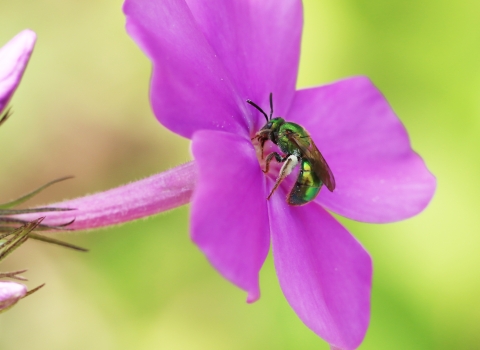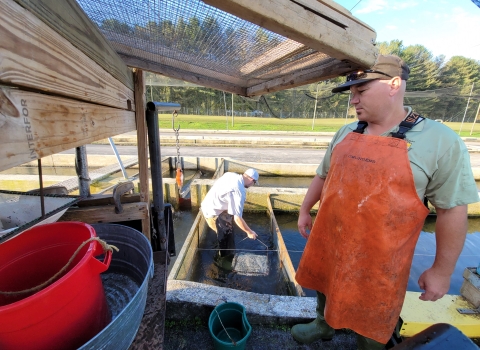ASHAWAY, RI – The U.S. Fish and Wildlife Service and The Nature Conservancy this week announced the completion of a dredging project that will improve fish passage fish passage
Fish passage is the ability of fish or other aquatic species to move freely throughout their life to find food, reproduce, and complete their natural migration cycles. Millions of barriers to fish passage across the country are fragmenting habitat and leading to species declines. The U.S. Fish and Wildlife Service's National Fish Passage Program is working to reconnect watersheds to benefit both wildlife and people.
Learn more about fish passage on the Pawcatuck River. The partners removed an obstruction that was steering migratory fish away from the fish ladder at the Potter Hill Dam.
On Tuesday, an excavator removed an underwater berm of sand and gravel that had formed over time at the entrance to the Potter Hill fish ladder. The berm was creating an eddy current below the dam that made it difficult for river herring and American shad to locate the entrance to the ladder. Adapted to swim upstream during their spring migration, fish were getting turned around in the swirling current and mistakenly swimming back downstream.
The project at Potter Hill Dam is part of a larger effort to improve fish passage and reduce flood risk in the lower Pawcatuck River. In November 2015, The Nature Conservancy and the U.S. Fish & Wildlife Service removed the White Rock Dam in Westerly, 3.3 miles below Potter Hill Dam. The river had not flown freely at White Rock since before the Revolutionary War, and the dam prevented up to 85 percent of river herring from migrating farther upstream. The removal of the White Rock Dam lent even greater urgency to further improving fish passage at Potter Hill Dam.
Under a cooperative agreement with the Service, The Nature Conservancy hired SumCo Eco-Contracting of Salem, Mass. to perform the work at Potter Hill. SumCo accomplished the dredging with a long-arm excavator, one of just a few such machines operating in southern New England. The machine’s 60-foot reach – more than twice that of traditional excavator – allowed it to be positioned on Maxson Street, above the river, on the Hopkinton side. The company successfully removed 17 cubic yards of material from the stream bed, without the expense of building a ramp and potential damage to the riverbank.
“The U.S. Fish and Wildlife Service has been a tremendous partner and advocate for resource protection on Pawcatuck River,” said Scott Comings, associate state director for The Nature Conservancy in Rhode Island. “We’re grateful to the Service, not only for funding the project but for providing the engineering expertise to make sure we fixed the problem at Potter Hill.”
The $10,000 project was supported by federal funding for Hurricane Sandy recovery, administered by Suzanne Paton, senior biologist for the Service’s Southern New England Coastal Program. “We’re proud to join with The Nature Conservancy in restoring habitat for migratory fish in the Pawcatuck River,” Paton said. “So many native predators depend on herring as part of their diet, from striped bass to seabirds to otters. By improving the conditions at Potter Hill, many more fish will be able to pass upstream to their spawning grounds, hopefully resulting in a stronger run over time.”
Bryan Sojkowski of the Service’s Fish Passage Engineering Group consulted on the design of the project and provided direct, onsite supervision of the contractor. The Rhode Island Department of Environmental Management’s Division of Fish & Wildlife operates the Potter Hill fish ladder and contributed new timber baffles as part of the project. The modified baffles will slow the water velocity within the fishway and allow migratory fish to pass through it more efficiently.
Additional partners on the project include the Wood-Pawcatuck Watershed Association, which has led fish passage projects farther upstream at Lower Shannock Falls, Horseshoe Falls, and Kenyon Mill dams.


